Unemployment is rising. We need an urgent plan to tackle it
New statistics published today rang loud alarm bills about the potential scale of the jobs crisis if government doesn’t act to tackle unemployment.
The Job Retention Scheme, argued for by unions, has helped protect work. But jobs, hours and vacancies are sharply down, pay is in decline, and over a million people are now on zero-hours contracts. The government must act now to protect and create jobs to prevent the threat of mass unemployment this autumn.
What today’s jobs statistics reveal
220,000 jobs were lost over the past quarter (April – June), the largest fall since the global recession. Of these, 100,000 were lost by younger workers (16-24) and 160,000 by older workers (65+). Across other ages there was a small gain of 40,000.
Self-employment is down by 240,000 over the quarter.
While these are hefty job losses the official figures for unemployment show little change, as many workers are instead categorised as ‘inactive’ – suggesting that many may want a job but are not currently able to look for one.
Separate payroll figures show a further fall in the number of employees into July. In total this measure of employees has fallen by 740,000 since January.
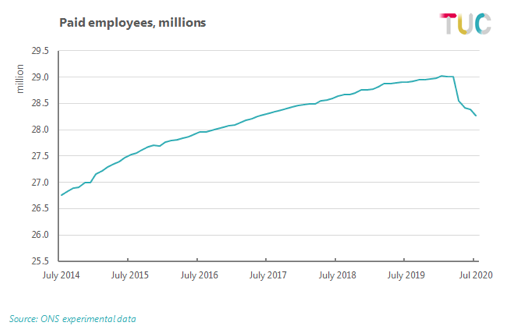
Job vacancies at a record low
The figures also show hundreds of thousands of people recorded as wanting work. While the inactivity figures overall rose by 80,000, there was a rise of 220,000 in the number of inactive people, (that is those not looking for a job, who nevertheless say they want work).
Vacancies, however, are at a record low, averaging 350,000 over the past two three-month periods. Even during the global recession, vacancies averaged 450,000 over 2009. The ONS point to a rebound in the latest period, but this is a relatively minor change.
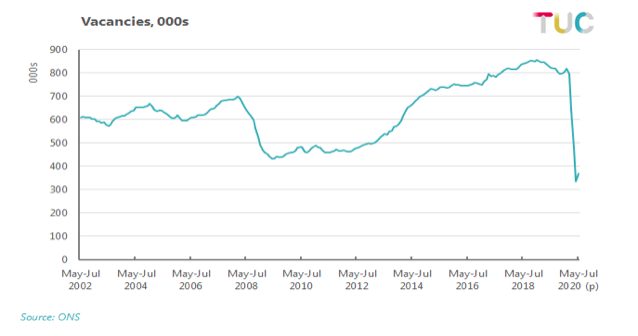
We know from the almost daily announcements that redundancies are rising – most recently at WH Smith, and Hays Travel. Official figures are now beginning to react as well, with redundancies up 27,000 on the quarter to a total of 134,000 – the biggest quarterly increase since 2012.
The job retention scheme is helping to protect jobs
The large job losses shown in the pay roll figures show around a 2.5 per cent fall in employment. But this is well below the 25 per cent fall in GDP (from January to May).
This is because of the protection provided by the Job Retention Scheme, with furloughed workers counted as employed – when they are not at the moment producing any ‘output’ that might count towards GDP.
According to the ONS, “Up to 5 million people in total looked to be furloughed in June”. This is down from the earlier peak of 9 million. (Note here that the ONS also warns that “part of that furloughing picture includes just under half a million people between (Apr-Jun) who tell us they are employed, but away from work and not being paid”.)
The closest match with the GDP data is hours worked, which are down 19% on a year ago. The chart shows this is the most severe decline in hours worked by far. From an individual perspective, full time average hours have fallen to 30.3, from 36.9 at the end of last year, while part time hours have fallen from from 16.2 to 11.6.
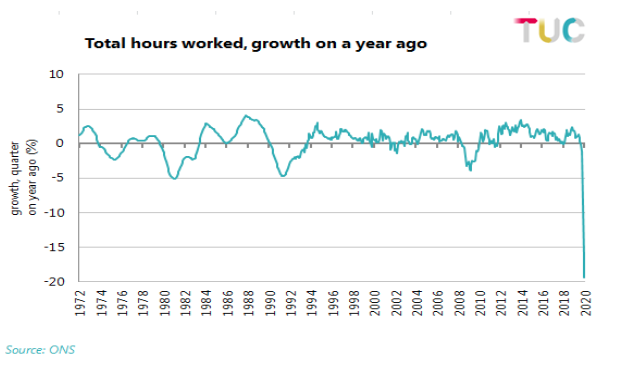
Pay rates are falling
The headline figures are showing that in 2020 Q2, regular pay fell by 0.2% on the year, the worst figure since published figures began in 2000. This may reflect changes due to people receiving less than their regular pay packet due to the Job Retention Scheme. Some industries have seen particularly large falls in pay on this measure – construction pay is -8.7%, retailing and distribution down -3.9% and manufacturing -2.5%.
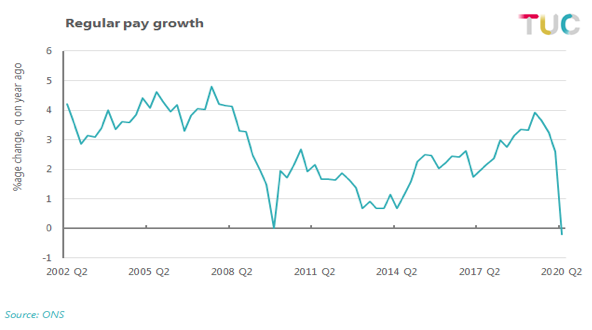
Zero-hours contracts
The number of people employed on a zero-hours contract has reached a record high. There are now 1.05 million people on zero-hours contracts, a 17 per cent increase compared to the same period last year. This is the first time on record that the number has topped a million.
Two industries in particular have seen a big growth in the number of people employed on a zero-hours contract: wholesale and retail (41 per cent) and health and social care (35 per cent). These are two industries that are currently in high demand, and account for significant numbers of key workers. This might suggest that these sectors are hiring new workers to meet demand, but unfortunately employing them on exploitative zero-hours contracts.
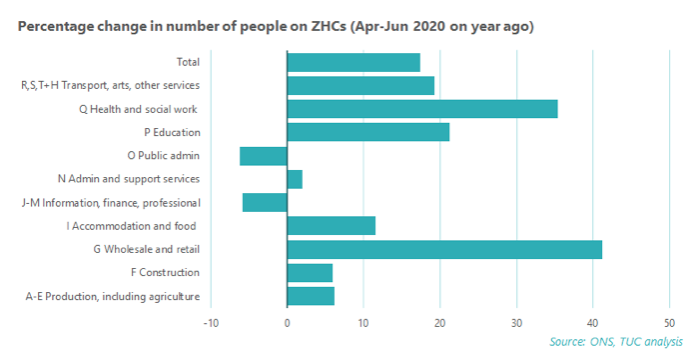
Greater security for workers would mean a stronger recovery. The government must abolish zero hours contracts now.
Regional differences
Across the UK, regions and nations are seeing falls in employment for those aged 16+, though the headline employment rates for those aged 16-64 have not yet moved significantly on average. This reflects the wider trend suggested by the ONS that a significant proportion of the fall in employment is driven by those aged 65+ in many parts of the country.
Notable exceptions are in the North East, West Midlands and Wales, which have seen increases in employment versus the previous quarter. The South West and East Midlands have seen both a fall in the employment of those aged 16+ and a change in the employment rate of 16-64 year-olds of similar levels, indicating that the fall in employment may be driven by younger workers.
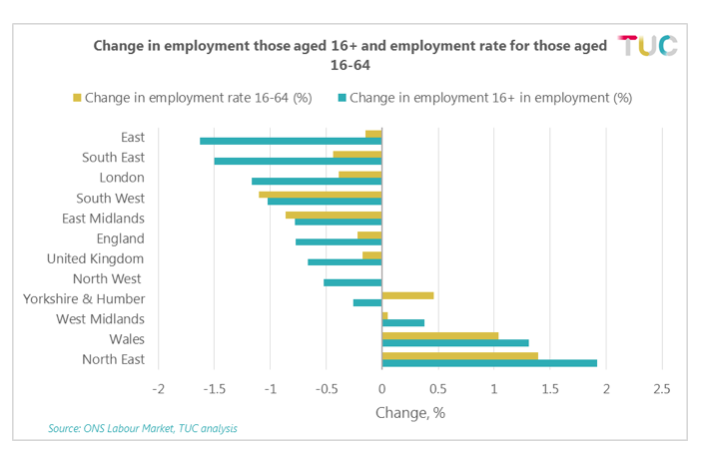
Government must to act now to avoid mass unemployment
Today’s figures show that mass unemployment is looming unless the government takes urgent action. They need to extend the job retention scheme for businesses with a viable future who can’t operate because of virus restrictions; invest in the jobs we need for the future in green industries, social care and across the public sector; and they must ensure a decent safety net is in place to help those who lose their jobs get back on their feet.
Stay Updated
Want to hear about our latest news and blogs?
Sign up now to get it straight to your inbox
